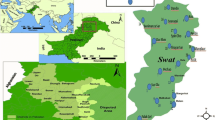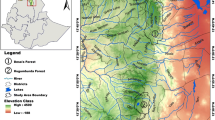Abstract
Assessing tree ages is important for the understanding of forest recruitment patterns and tree growth. However, little experience exists in the subtropics and accurate aging usually involves potentially damaging techniques such as tree coring or even the use of entire cross sections, which is not recommendable in endangered species or ecosystems. We provide an example of how age may be predicted on the basis of tree size and site conditions, using Polylepis australis of Central Argentina. Our study was conducted in two entire river basins where 96 independent trees were successfully cored for age analysis. Site and tree characteristics were registered and tree age determined through standard dendrochronological techniques. The multiple regression procedure selected tree circumference and proportion of rock under the tree canopy as significant variables explaining 48% of the variation in number of growth rings. Trees surrounded by rock clearly grew slower than those surrounded by a higher proportion of soil and vegetation. A comparison with a one site study shows that the ability to predict P. australis age is clearly reduced when geographical range is extended but the explanatory power of our model is still high enough for certain applications and within the range of other one site studies. We suggest that tree size and site characteristics may be used to predict age in other subtropical mountain forests with a well marked growth season.



Similar content being viewed by others
References
Acosta A (1986) Estructura poblacional de Polylepis australis. In: MAB 6: Efecto de las actividades humanas sobre los ecosistemas montañosos y de tundra. MAB-PNUMA, pp 392–401
Argollo J, Soliz C, Villalba R (2004) Potencialidad dendrocronológica de Polylepis tarapacana en los Andes Centrales de Bolivia. Eco Bol 29:5–24
Brotherson JD, Carman JG, Szyska LA (1984) Stem-diameter age relationships of Tamarix ramosissima in Central Utah. J Range Manage 34:362–364
Cabido MR (1985) Las comunidades vegetales de la Pampa de Achala, Sierras de Córdoba, Argentina. Doc Phytosociol 9:431–443
Cingolani AM, Cabido MR, Renison D, Solís Neffa V (2004) Combined effects of environment and grazing on vegetation structure in Argentine granite grasslands. J Veg Sci 14:223–232
Cingolani A, Renison D, Tecco P, Gurvich D, Cabido M (2007) Predicting cover types in a mountain range with long evolutionary grazing history: a GIS approach. J Biogeog. doi: 10.1111/j.1365-2699.2007.01807.x
Duncan RP (1989) An evaluation of errors in tree age estimates based on increments cores in Kahukatea (Dacrycarpus dacrydioides). N Z J Nat Sci 16:31–37
Echeverría C, Lara A (2004) Growth patterns of secondary Nothofagus oblique—N. alpina forests in southern Chile. For Ecol Manage 195:29–43
Ellenberg H (1979) Man’s influence on tropical mountain ecosystems in South America. J Ecol 67:401–416
Enrico L, Funes G, Cabido MR (2004) Regeneration of Polylepis australis Bitt. in mountains of central Argentina. For Ecol Manage 190:301–309
Fjeldså J, Kessler M (1996) Conserving the biological diversity of Polylepis woodlands of the highland of Peru and Bolivia. A contribution to sustainable natural resource management in the Andes. NORDECO, Copenhagen
Fritts HC (1971) Dendroclimatology and dendroecology. Quaternary Res 1:419–449
Fritts HC (1976) Tree rings and climate. Academic Press, London
Gustell SL, Johnson EA (2002) Accurately ageing trees and examining their height-growth rates: implications for interpreting forest dynamics. J Ecol 90:153–166
Grau HR, Easdale TA, Paolini L (2003) Subtropical dendroecology-dating disturbances and forest dynamics in northwestern Argentina montane ecosystems. For Ecol Manage 177:131–143
Hensen I (1995) Die vegetation von Polylepis-Wäldern der Ostkordillere Boliviens. Phytocoenologia 25:235–277
Hensen I (2002) Impacts of anthropogenic activity on the vegetation of Polylepis woodland in the region of Cochabamba, Bolivia. Ecotropica 8:183–203
Kessler M (2000) Observations on a human-induced fire event at a humid timberline in the Bolivian Andes. Ecotropica 6:83–93
Kessler M (2002) The “Polylepis problem”: where do we stand? Ecotropica 8:97–110
Lauer W, Rafiqpoor MD, Theisen I (2001) Physiogeographie, Vegetation und Syntaxonomie der Flora des Páramo de Papallacta (Ostkordillere Ecuador). Erdwissenschaftliche Forschung 39, Stuttgart
Lieberman D, Lieberman M, Hartshon G, Peralta R (1985) Growth rates and age–size relationships of tropical wet forest trees in Costa Rica. J Trop Ecol 1:97–109
Loewenstein EF, Johnson PS, Garrett HE (2000) Age and diameter structure of a managed uneven-aged oak forest. Can J For Res 31:1060–1070
Marcora P, Hensen I, Renison D, Seltmann P, Wesche K The performance of Polylepis australis trees along their entire altitudinal range: implications of climate change for their conservation. Divers Distrib, in press
McConnell BM, Smith JG (1963) Estimation of bitterbrush age from stem-diameter measurements. Ecology 44:579–581
Morales MS, Villalba R, Grau HR, Paolini L (2004) Rainfall-controlled tree growth in high-elevation subtropical treelines. Ecology 85:3080–3089
Morey HF (1936) Age–size relationships of hearts content, a virgin forest in northwestern Pennsylvania. Ecology 17:251–257
Norton DA, Palmer JG, Odgen J (1987) Dendroecological studies in New Zealand. 1. An evaluation of tree age estimates based on increment cores. N Z J Bot 25:373–383
O’Brien ST, Hubbell SP, Spiro P, Condit R, Foster RB (1995) Diameter, height, crown, and age relationship in eight neotropical tree species. Ecology 76:1926–1939
Perryman BL, Olson RA (2000) Age-stem diameter relationships of big sagegrush and their management implications. J Range Manage 53:352–346
Renison D, Cingolani AM, Suarez R (2002) Efectos del fuego sobre un bosquecillo de Polylepis australis (Rosaceae) en las montañas de Córdoba, Argentina. Rev Chil Hist Nat 75:719–727
Renison D, Cingolani AM, Suarez R, Menoyo E, Coutsiers C, Sobral A, Hensen I (2005) The restoration of degraded mountain forests: effects of seed provenance and microsite characteristics on Polylepis australis seedling survival and growth in Central Argentina. Rest Ecol 13:129–135
Renison D, Hensen I, Suarez R, Cingolani AM (2006) Cover and growth habit of Polylepis woodlands and shrublands in the mountains of central Argentina: human or environmental influence? J Biogeogr 33:876–887
Renison D, Bellis L, Guzmán GF, Grau R, Pacheco S, Rivera L, Politi N, Martin E, Cuyckens E, Marcora P, Robledo G, Cingolani AM, Perasso L, Cornell F, Dominguez J, Landi M, Hensen I Estado de conservación de los bosques Argentinos de Polylepis y su avifauna. In: “Una Contribución al Conocimiento de los Bosques Altoandinos de Polylepis: Distribución, Diversidad y Estado Actual de los Bosques más Altos del Mundo”. American Bird Conservancy—Comunidad Andina, Lima, Perú, in press
Roig F, Fernández M, Gareca E, Altamirano S, Monge S (2001) Dendrochronological studies in the humid puna environments of Bolivia. Rev Bol Ecol 9:3–13
Rozas V (2003) Tree age estimates in Fagus sylvatica and Quercus robur: testing previous and improved methods. Plant Ecol 167:193–212
Stokes MA, Smiley TL (1968) An introduction to tree-ring dating. University of Chicago Press, Chicago
Teich I, Cingolani AM, Renison D, Hensen I, Giorgis M (2005) Do domestic herbivores retard Polylepis australis Bitt. woodland recovery in the mountains of Córdoba, Argentina? For Ecol Manage 219:229–241
Tyrrell LE, Crow TR (1994) Structural characteristics of old-growth Hemlock-Hardwood forests in relation to age. Ecology 75:370–386
UNEP-WCMC (2004) United Nations Environment Programme. World Conservation Monitoring Center; http://www.unep-wcmc.org
Veblen TT (1986) Age and size structure of subalpine forests in the Colorado Front Range. Bol Torr Bot Club 113:225–356
Villalba R, Veblen TT (1997) Improving estimates of total tree ages based on increment core samples. Ecoscience 4:534–542
Villalba R, Veblen TT, Ogden J (1994) Climatic influences on the growth of subalpine trees in the Colorado front range. Ecology 75:1450–1462
Wong C, Lertzman P (2001) Errors in estimating tree age: implications for studies of stand dynamics. Can J For Res 31:1262–1271
Acknowledgements
We are very grateful to the Volkswagen Foundation Germany for funding this study, to R. Suarez and E. Galli who assisted in the coring, and to ECOTONO lab for increment tree-ring measuring facilities. The National Parks authorities provided permits to conduct part of this study in Quebrada del Condorito National Park. The first and second authors are a fellow and assistant researcher of CONICET (Argentina).
Author information
Authors and Affiliations
Corresponding author
Rights and permissions
About this article
Cite this article
Suarez, M.L., Renison, D., Marcora, P. et al. Age–size–habitat relationships for Polylepis australis: dealing with endangered forest ecosystems. Biodivers Conserv 17, 2617–2625 (2008). https://doi.org/10.1007/s10531-008-9336-1
Received:
Accepted:
Published:
Issue Date:
DOI: https://doi.org/10.1007/s10531-008-9336-1




